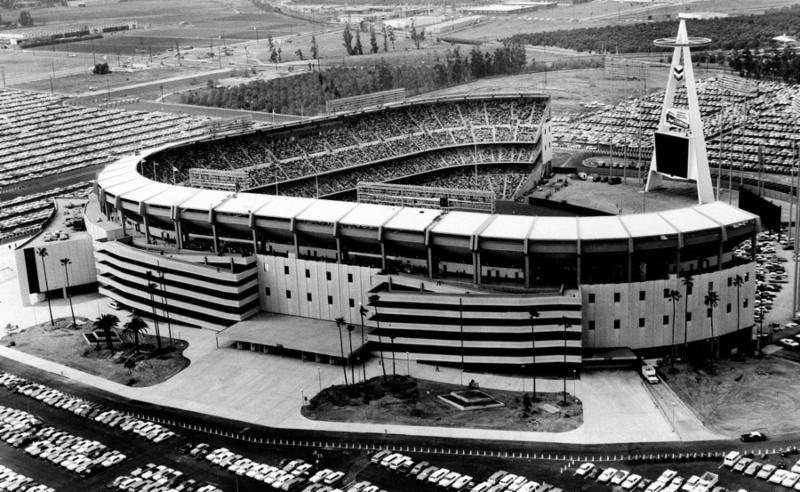With their decision to opt out of their Angel Stadium lease, the Los Angeles Angels left plenty of questions about their future. Among those that loom the largest are whether the team will relocate, come to an agreement to renovate Angel Stadium, or build a new ballpark in Anaheim or elsewhere in Southern California.
Last week, the Angels informed the City of Anaheim that they are opting out of the lease agreement for Angel Stadium. In some ways, the move was a surprise—as recently as February 2017, Angels owner Arte Moreno indicated that the team would stay at Angel Stadium through 2029—but it was also a clear sign that the Angels are not content with the status quo. Had they not opted out of their agreement by last Tuesday, the Angels would have had to wait until 2028 for another opportunity. By opting out of their agreement, the Angels are now able to explore their long-term ballpark options much sooner.
Before delving into those potential options, it is important to note the history of Angel Stadium and the more recent history of the Angels seeking a new or renovated ballpark. Opening April 19, 1966 as Anaheim Stadium, Angel Stadium is currently the fourth-oldest ballpark in Major League Baseball—behind only Fenway Park (1912), Wrigley Field (1914), and Dodger Stadium (1962). It was first constructed as a baseball-only venue but was expanded and fully enclosed to accommodate the NFL’s Los Angeles Rams in 1980.
When the Rams relocated to St. Louis in 1995, Anaheim Stadium was effectively back to its original purpose. That cleared the way for a renovation led by Disney under a plan from Robert A.M. Stern and Populous that was completed in 1998, giving the ballpark—which briefly became Edison International Field of Anaheim before assuming the current Angel Stadium name in 2004—its current look and feel. (For a complete look at the history of Angel Stadium, see the story we published in 2016 to honor the ballpark’s 50th year.)
That renovation has not aged particularly well, however, and the Angels have previously made overtures about wanting an alternative. As far as back as 2013, the Angels hinted at a move elsewhere in Southern California if they were unable to complete an agreement with the City of Anaheim that called for Moreno to put as much as $150 million into renovations in exchange for development rights for the area surrounding the ballpark. Downtown Los Angeles and Irvine were among the speculated destinations, but no alternatives gathered as much traction as Tustin—a smaller city southeast of Anaheim.
The Angels pursued a new ballpark in Tustin at the site of the city’s decommissioned Marine Corps Air Station, but financing proved to be a challenge there. Once it was determined that Tustin was not a viable option, it appeared that the Angels could revisit an Angel Stadium renovation, but no plans ever emerged.
In that sense, the Angels’ apparent desire for an alternative to Angel Stadium is not new. The club sought for a few years to renovate or replace the ballpark, only for those discussion to end without resolution. Now, however, they will be back at the forefront with the team’s decision to opt out of its lease.
From the surface, the opt-out—which means the Angels are not obligated to play at Angel Stadium beyond 2019—opens the door for a few possibilities. While relocation to another market would seemingly be on the table, it seems unlikely that the team would leave the Greater Los Angeles area. Playing in that region gives the Angels a substantial boost from a television viewership and revenue standpoint, with a current cable deal worth $150 million annually. That is not something that can be easily made up elsewhere, even as west coast cities like Portland and Las Vegas are speculated as possible MLB homes.
If the club’s plans are to stay in Greater Los Angeles, then it will have a few factors to consider. The notion of public financing for a professional sports venue is increasingly becoming a nonstarter throughout California, so any ballpark plan will likely have to include a substantial amount of private financing. Land in downtown Los Angeles for a ballpark will come at a premium, and whether there are viable options elsewhere in Southern California remains to be seen.
As for Anaheim, the club could explore an agreement to stay there. The mayoral position and three city council seats are set to turnover with November’s election, which may give the Angels a fresh start in negotiations for a new or renovated ballpark.
Angel Stadium is also in an area that makes sense for a new or renovated ballpark. Dubbed The Platinum Triangle, the area that includes the ballpark and surrounding sites has become a target for development, giving the once primarily suburban setting a more downtown-like feel. Current and future development, combined with existing advantages such as freeway and transit access, would make it a good site for a new or renovated ballpark.
Ultimately, Angel Stadium and the land surrounding it may present some options. The Angels could revisit their earlier proposal to renovate Angel Stadium in exchange for development rights, hoping that negotiations with Anaheim officials result in an agreement. Or, the team may decide that Angel Stadium is not suited for what would essentially be a fourth iteration, and instead opt to build anew in the ballpark’s vast parking lot while redeveloping the current site.
Adjoining development is a major trend in ballpark construction, and the Angels might be one of the next teams to tap into that trend. Options elsewhere may present themselves, but the idea of the Angels staying in Anaheim should not be easily dismissed at this stage.
This article first appeared in the Ballpark Digest newsletter. Are you a subscriber? It’s free, and you’ll see features like this before they appear on the Web. Go here to subscribe to the Ballpark Digest newsletter.

